Republic of Korea Armed Forces
The Republic of Korea Armed Forces (Korean: 대한민국 국군, 大韓民國 國軍, lit. 'Republic of Korea National Military'), also known as the ROK Armed Forces, are the armed forces of South Korea. The ROK Armed Forces is one of the largest standing armed forces in the world with a reported personnel strength of 3,699,000 in 2018 (579,000 active and 2,700,000 reserve). South Korea has one of the highest defense budgets in the world, ranking 10th globally in 2019, with a budget of nearly $44 billion U.S. dollars. The South Korean military is ranked as the 6th most powerful military force on the planet as of 2020.[4]
| Republic of Korea Armed Forces | |
|---|---|
| 대한민국 국군 大韓民國 國軍 Daehanminguk Gukgun' | |
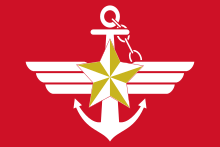 Flag of the Republic of Korea Armed Forces | |
| Founded | 1948 |
| Service branches | |
| Headquarters | Ministry of National Defense, Yongsan-gu, Seoul |
| Leadership | |
| Commander-in-Chief | |
| Minister of National Defense | |
| Chairman of the Joint Chiefs of Staff | |
| Manpower | |
| Military age | Voluntary from 18, mandatory 20 to 38 years of age for male, wartime conscription 18–40 years of age |
| Conscription | 18–22 months depending on the branch (From 2020) |
| Active personnel | 599,000 (2018)[1] (ranked 7th) |
| Reserve personnel | 3,100,000 (2018)[1] |
| Deployed personnel | 13 nations, 1,095 troops (2018) List of major deployment[1]
|
| Expenditures | |
| Budget | US$43.9 billion(2019)[2] (ranked 10th) |
| Percent of GDP | 2.7%(2019)[2] |
| Industry | |
| Domestic suppliers | List of major suppliers [3]
|
| Foreign suppliers | List of major suppliers |
| Related articles | |
| History | Korean War (1950–1953) Vietnam War (1965–1973) Persian Gulf War (1990–1991) War in Afghanistan (2001–2016) Iraq War (2003–2011) |
| Ranks | Comparative military ranks of Korea |
The Republic of Korea Armed Forces were founded in 1948, following the establishment of the South Korean government after Korea's liberation from the Empire of Japan. South Korea's military forces are responsible for maintaining the sovereignty and territorial integrity of the state, and also engage in peacekeeping operations and humanitarian, disaster-relief efforts worldwide.
History
_1.jpg)
The origin of the Republic of Korea Armed Forces can be traced back to the Korean Independence Army, which was established by the Provisional Government of Korea in exile in Chongking, Republic of China in 1940 during the Japanese rule of Korea. Many of its members became part of the South Korean armed forces later.[5] In addition, some ethnic Korean Kuomintang and Manchukuo soldiers also contributed to the forces.
After Korea was liberated from the Empire of Japan on August 15, 1945, the Korean Constabulary and the Korean Coast Guard (organized by Sohn Won-yil and others) were established through the United States Army Military Government in Korea. The Korean Constabulary and the Korean Coast Guard became the Republic of Korea Army and Republic of Korea Navy respectively, and formed the Republic of Korea Armed Forces after the South Korean government was established on August 15, 1948. The Republic of Korea Air Force was founded in October 1949.
The South Korean armed forces remained largely constabulary forces until the outbreak of the Korean War on June 25, 1950, requiring the United Nations to intervene with United States-led forces. The South Korean military rapidly developed during the Korean War, despite suffering enormous casualties. As the Soviets had armed North Korea, the U.S. armed and trained the South Korean military throughout the Korean War. After the Korean War, South Korea established a joint military partnership with the United States, termed the ROK-U.S. Alliance,[6] as outlined by the Mutual Defense Treaty. During the Vietnam War, the ROK Army and ROK Marines were among those fighting alongside South Vietnam and the United States.
In the 1970s, through the Park Chung-hee Administration's "Yulgok Plan", South Korea began to build up self-reliant, national defense capability.[7] During South Korea's period of rapid growth in the 1980s, the military modernized, benefiting from several government-sponsored technology transfer projects and indigenous defense capability initiatives. In the 1990s, "South Korean industries provided about 70 percent of the weapons, ammunition, communications and other types of equipment, vehicles, clothing, and other supplies needed by the military."[8]
Today, the South Korean armed forces enjoy a good mix of avant-garde as well as older conventional weapons. Its capabilities include many sophisticated U.S. and European weapon systems, complemented by a growing and increasingly more advanced indigenous defense manufacturing sector. For example, by taking advantage of the strong local shipbuilding industry, the ROK Navy has embarked on a rigorous modernization plan with ambitions to become a blue-water navy in the 2020s.[9]
Future
The ROK military forces are undergoing rapid modernization in preparation for assuming wartime operational control of the ROK's defenses.[6] Several cutting-edge military systems are currently being inducted.[9]
Based on the Moon Jae-in Administration's "Defense Reform 2.0" and in line with the overall troop drawdown scheme, the number of generals and admirals will be reduced by 17 percent from the current 436 to 360 by 2022 to reduce the bloated top command apparatus. This means the removal of 66 general-level positions for the Army and five each for the Navy and Air Force. At the same time, the ROK Armed Forces will see a reduction in active duty personnel from 640,000 to 517,000, and the length of compulsory military service will also be reduced to 18 – 22 months by 2022.[10]
Command structure
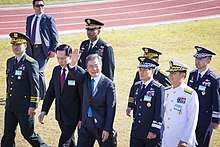
Command over the ROK Armed Forces is established in the Constitution. The President is the Commander-in-Chief Forces ex officio. The military authority runs from the President to the Minister of National Defense, who is often to be (but not legally bound to be) a retired 4-star general. The President and Minister of National Defense are in charge of the entire military establishment, maintaining civilian control of the military. The Minister of National Defense, by order of the President, takes charge of military affairs, and supervises the Chairman of the Joint Chiefs of Staff and the chief of staff of each service of the Armed Forces.
To coordinate military strategy with political affairs, the President has a National Security Council headed by the National Security Advisor.
Joint Chiefs of Staff
The Joint Chiefs of Staff consists of the Chairman of the Joint Chiefs of Staff, and the military service chiefs from the Army, Navy, and Air Force. Unlike the U.S. counterpart, operational command of combat units falls within the purview of the Chairman of the Joint Chiefs of Staff who reports to the Minister of National Defense.
The Chairman of the Joint Chiefs of Staff, a 4-star General or Admiral, is the senior officer of the Armed Forces. The Chairman of the Joint Chiefs of Staff assists the Minister of National Defense with regard to operational command authority, and supervises the combat units of each service of the Armed Forces, by order of the Minister of National Defense. The chain of operational control runs straight from the Chairman of the Joint Chiefs of Staff to the commandants of the Army, Navy, and Air Force operational commands. The respective chiefs of staff of each service branch (Army, Navy, and Air Force) has administrative control over his or her own service.[11]
Service branches
The ROK Armed Forces consists of the ROK Army (Korean: 대한민국 육군), ROK Navy (대한민국 해군), and ROK Air Force (대한민국 공군). The ROK Marine Corps (대한민국 해병대) functions as a branch of the Navy. The ROK Reserve Forces (대한민국 예비군) is a reserve component.
ROK Army
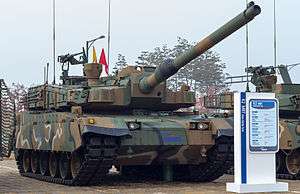
The ROK Army (ROKA) is by far the largest of the military branches, with about 464,000 personnel as of 2019. This comes as a response to both the mountainous terrain native to the Korean Peninsula (70% mountainous) as well as the heavy North Korean presence, with its 1-million-strong army, two-thirds of which is permanently garrisoned in the frontline near the DMZ. The current administration has initiated a program of self-defense, whereby South Korea would be able to fully counter the North Korean threat with purely domestic means within the next two decades.
The ROK Army was formerly organized into three armies: the First Army (FROKA), Third Army (TROKA) and Second Operational Command each with its own headquarters, corps (not Second Operational Command), and divisions. The Third Army was responsible for the defense of the capital as well as the western section of the DMZ. The First Army was responsible for the defense of the eastern section of the DMZ whereas the Second Operational Command formed the rearguard.

Under a restructuring plan aimed at reducing redundancy, the First and Third Armies will be incorporated into the newly formed First Operations Command, whereas the Second ROK Army has been converted into the Second Operational Command. The army consists of the Army Headquarters, the Aviation Command, and the Special Warfare Command, with 9 corps, 36 divisions, some 464,000 troops and estimated as many as 5,850 tanks and armored vehicles, 11,337 artillery systems, 7,032 missile defense systems and 13,000 infantry support systems.[9]
The army will take the brunt of the personnel reduction part of the Defense Reform 307. Associated with this personnel reduction would be a significant reduction in the ROK Army force structure, in particular decreasing the current force of 47 divisions (active duty and reserve) down to a force of about 28 divisions.
ROK Navy
_returns_to_Joint_Base_Pearl_Harbor-Hickam_after_participating_in_Rim_of_the_Pacific_(RIMPAC)_2010_exercises.jpg)
The ROK Navy (ROKN) is responsible for naval and amphibious operations.[12] The ROK Navy has about 70,000 regular personnel including 29,000 Republic of Korea Marines. There are about 150 commissioned ships with the ROK Navy (a total displacement of about 215,000 tonnes[13]). The naval aviation force consists of about 70 fixed-wing and rotary-wing aircraft.
The Republic of Korea Navy includes the Republic of Korea Navy Headquarters, Republic of Korea Fleet, and Republic of Korea Marine Corps. The Chief of Naval Operations (CNO) is the highest-ranking officer of the ROK Navy, and oversees the administration of organizing, recruiting, training, equipping, supplying, and mobilizing the ROK Navy. The Republic of Korea Fleet is the highest operational command of the ROK Navy.
Since the 1990s, the ROK Navy has been trying to build an ocean-going fleet to protect the sea lines of communication. During Admiral An Pyong-tae's tenure as CNO, President Kim Young-sam supported the Navy by approving a long-term shipbuilding plan for the ocean-going navy. In the first decade of the 21st century, the ROK Navy launched the lead ships of larger and better equipped warships with local shipbuilders: In 2002, ROKS Chungmugong Yi Sunshin (DDH 975), a 4,500-ton destroyer, was launched; in 2005, the 14,000-ton amphibious warfare ship, ROKS Dokdo (LPH 6111) was launched; in 2006, the ROK Navy launched ROKS Sohn Wonyil (SS 072), an 1,800-ton Type 214 submarine with Air-Independent propulsion (AIP) system. In 2007, the ROK Navy launched the lead ship (DDG 991) of Sejong the Great class destroyers with the Aegis combat system.
The ROK Navy completed a new naval base called Jeju Civilian-Military Complex Port in 2016 on the southern coast of Jeju Island to protect the sea lines of communication.[14] In order to support ocean-going operations, the ROK Navy commissioned the 10,000-ton logistics support ship, ROKS Soyang (AOE 51), and launched the first locally designed 3,000-ton submarine, Dosan Ahn Changho (SS 083) in 2018.[15] The ROK Navy continues to upgrade ongoing shipbuilding programs such as the Korean Submarine (KSS), Korean Destroyer Experimental (KDX), Frigate Experimental (FFX), and Landing Transport Experimental (LPX).
The ROK Navy aims to become a blue-water navy in the 2020s.[16][17]
ROK Marine Corps
.jpg)
The ROK Marine Corps (ROKMC) is a branch of the Republic of Korea Navy responsible for amphibious operations,[18] and also functions as a rapid reaction force and a strategic reserve. The ROK Marine Corps, with 29,000 personnel, is organized into two divisions and two brigades under the Headquarters ROK Marine Corps. The ROK Marine Corps has about 300 tracked vehicles including assault amphibious vehicles, main battle tanks, and self-propelled artillery.
The Commandant of the Republic of Korea Marine Corps is a three-star general. After the bombardment of Yeonpyeong in 2010, the Commandant of the ROKMC also holds the commander position of the Northwest Islands Defense Command (NWIDC).
ROK Air Force
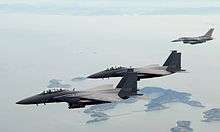
The ROK Air Force (ROKAF) maintains a modern air force in order to defend itself from various modes of threats, including the North Korean Army. The ROK Air Force fields some 450 combat aircraft of American design. In contrast, the North Korean Army has roughly 650 combat aircraft, but mostly obsolete types of Soviet and Chinese origin.
Korea began a program for the development of indigenous jet trainers beginning in 1997. This project eventually culminated in the KAI T-50, dubbed the "Golden Eagle" which is used as a trainer for jet pilots, now being exported to Indonesia. A multirole all-weather version of the T-50 is the modified FA-50, which can be externally fitted with Rafael's Sky Shield or LIG Nex1's ALQ-200K ECM pods, Sniper or LITENING targeting pods, and Condor 2 reconnaissance pods to further improve the fighter's electronic warfare, reconnaissance, and targeting capabilities.[19][20] Other improved weapon systems over FA-50 include SPICE multifunctional guidance kits,[21] Textron CBU-97/105 Sensor Fuzed Weapon with WCMD tail kits, JDAM, and JDAM-ER for more comprehensive air-to-ground operations, and AIM-120 missiles for BVR air-to-air operations.[22] FA-50 has provisions for, but does not yet integrate, Python and Derby missiles, also produced by Rafael, and other anti-ship missiles, stand-off weapons, and sensors to be domestically developed by Korea.[23][24][25]
The Republic of Korea Air Force also expressed interests in acquiring the RQ-4 Global Hawk and Joint Direct Attack Munition kits to further improve their intelligence and offensive capabilities.
The replacement programs for the F-4D/E and F-5A/B/E/F are the KTX-2 and F-X, respectively. The latter has been fulfilled by the Boeing F-15K.[26]
The South Korean government also announced its plan to develop indigenous helicopter manufacturing capacities to replace the aging UH-1 helicopters, many of which had seen service during the Vietnam War. The program originally included plans for the development of both a civilian and a military helicopter. This was later revised and gave priority to the utility helicopter program. Based on the success and experience of the civilian KMH (Korean Multi-purpose Helicopter) the attack helicopter, which would share a common configuration, will be developed.
Personnel
Conscription in South Korea requires male citizens over the age of 18 to perform compulsory military service.[27] Women are not required to perform military service, but they may volunteer as officers, warrant officers, or non-commissioned officers.[28]
The length of compulsory military service varies based on service branches: Active duty enlisted personnel serve 18 months in the Army or Marine Corps, 20 months in the Navy, and 21 months in the Air Force (the length of military service will be reduced to 18 – 22 months by 2022.).[10] Commissioned officers, warrant officers, and non-commissioned officers are volunteer-based, and serve longer terms than those of enlisted personnel, or as career. Non-active duty personnel such as social work personnel serve for various lengths. After conscripts finish their military service, they are automatically placed on the reserve roster.
Ranks
In the South Korean armed forces, ranks fall into one of four categories: commissioned officer, warrant officer, non-commissioned officer, and junior enlisted ("Byeong"), in decreasing order of authority. Commissioned officer ranks are subdivided into "Jangseong"-level (general) officers, "Yeonggwan"-level (field-grade) officers, and "Wigwan"-level (company-grade) officers. All three branches of the South Korean Armed Forces share the same rank insignia and titles in Korean (The English titles are given as comparative examples with the US Army ranks.).
ROK Navy commissioned officer ranks have two distinct sets of rank insignia: On dress uniform a series of stripes similar to Commonwealth naval ranks are worn; on service uniforms, working uniforms, and special uniform situations (combat utilities and flight suits), the rank insignia are the same as the equivalent rank in the Army or the Air Force.
| Commissioned officers (장교; 將校; Janggyo) | |||||||||||
|---|---|---|---|---|---|---|---|---|---|---|---|
| Jangseong (장성; 將星) | Yeonggwan (영관; 領官) | Wigwan (위관; 尉官) | |||||||||
| Insignia | 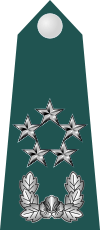 |
 |
 |
 |
 |
 |
 |
 |
 |
 |
 |
| Rank (ROK Armed Forces) | Wonsu (Korean: 원수; Hanja: 元帥) | Daejang (대장; 大將) | Jungjang (중장; 中將) | Sojang (소장; 少將) | Junjang (준장; 准將) | Daeryeong (대령; 大領) | Jungnyeong (중령; 中領) | Soryeong (소령; 少領) | Daewi (대위; 大尉) | Jungwi (중위; 中尉) | Sowi (소위; 少尉) |
| Translation | General of the Army | General | Lieutenant General | Major General | Brigadier General | Colonel | Lieutenant Colonel | Major | Captain | First Lieutenant | Second Lieutenant |
| Warrant officers (준사관; 准士官; Junsagwan) |
Non-Commissioned officers (부사관; 副士官; Busagwan) | Enlisted (병; 兵; Byeong) | |||||||
|---|---|---|---|---|---|---|---|---|---|
| Insignia | 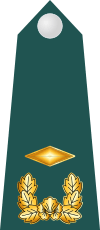 |
 |
 |
 |
 |
||||
| Rank (ROK Armed Forces) | Junwi (준위; 准尉) | Wonsa (원사; 元士) | Sangsa (상사; 上士) | Jungsa (중사; 中士) | Hasa (하사; 下士) | Byeongjang (병장; 兵長) | Sangdeungbyeong (상등병; 上等兵) | Ildeungbyeong (일등병; 1等兵) | Ideungbyeong (이등병; 2等兵) |
| Translation | Warrant Officer | Sergeant Major | Master Sergeant | Sergeant First Class | Staff Sergeant | Sergeant | Corporal | Private First Class | Private |
Note 1: No one held the five-star rank Wonsu in the history of the ROK Armed Forces.
Note 2: Ideungbyeong (Korean: 이등병; Hanja: 2等兵), Ildeungbyeong (일등병; 1等兵), and Sangdeungbyeong (상등병; 上等兵) are commonly referred to as Ibyeong, Ilbyeong, and Sangbyeong respectively.
Budget
South Korea has one of the highest defense budgets in the world, ranking 10th globally in 2019, with a budget of nearly $44 billion U.S. dollars.
| Year | Amount (KRW) | % of GDP | % of Gov Budget | % of change |
|---|---|---|---|---|
| 1980 | 2.25 trillion | 5.69 | 34.7 | 46.2 |
| 1981 | 2.70 trillion | 5.47 | 33.6 | 20.1 |
| 1982 | 3.12 trillion | 5.49 | 33.5 | 15.7 |
| 1983 | 3.27 trillion | 4.85 | 31.4 | 4.9 |
| 1984 | 3.31 trillion | 4.25 | 29.6 | 1.0 |
| 1985 | 3.69 trillion | 4.23 | 29.4 | 11.6 |
| 1986 | 4.16 trillion | 4.08 | 30.1 | 12.7 |
| 1987 | 4.75 trillion | 3.95 | 29.6 | 14.1 |
| 1988 | 5.52 trillion | 3.83 | 30.0 | 16.3 |
| 1989 | 6.01 trillion | 3.68 | 27.3 | 9.0 |
| 1990 | 6.64 trillion | 3.36 | 24.2 | 10.4 |
| 1991 | 7.48 trillion | 3.13 | 23.8 | 12.6 |
| 1992 | 8.41 trillion | 3.08 | 25.1 | 12.5 |
| 1993 | 9.22 trillion | 2.97 | 24.2 | 9.6 |
| 1994 | 10.08 trillion | 2.75 | 23.3 | 9.3 |
| 1995 | 11.07 trillion | 2.58 | 21.4 | 9.9 |
| 1996 | 12.24 trillion | 2.54 | 20.8 | 10.6 |
| 1997 | 13.79 trillion | 2.60 | 20.7 | 12.6 |
| 1998 | 13.80 trillion | 2.63 | 18.3 | 0.1 |
| 1999 | 13.75 trillion | 2.38 | 16.4 | -0.4 |
| 2000 | 14.48 trillion | 2.28 | 16.3 | 5.3 |
| 2001 | 15.39 trillion | 2.24 | 15.5 | 6.3 |
| 2002 | 16.36 trillion | 2.15 | 14.9 | 6.3 |
| 2003 | 17.51 trillion | 2.16 | 14.8 | 7.0 |
| 2004 | 18.94 trillion | 2.16 | 15.8 | 8.1 |
| 2005 | 21.10 trillion | 2.29 | 15.6 | 11.4 |
| 2006 | 22.51 trillion | 2.33 | 15.3 | 6.7 |
| 2007 | 24.50 trillion | 2.35 | 15.7 | 8.8 |
| 2008 | 26.65 trillion | 2.41 | 14.8 | 8.8 |
| 2009 | 28.98 trillion | 2.52 | 14.2 | 8.7 |
| 2010 | 29.56 trillion | 2.34 | 14.7 | 2.0 |
| 2011 | 31.40 trillion | 2.36 | 15.0 | 6.2 |
| 2012 | 32.96 trillion | 2.39 | 14.8 | 5.0 |
| 2013 | 34.50 trillion | 2.42 | 14.3 | 4.7 |
| 2014 | 35.71 trillion | 2.38 | 14.4 | 3.5 |
| 2015 | 36.44 trillion | 2.60 | 12.7 | 4.9 |
Overseas deployments
As part of its mission, the ROK Armed Forces have engaged in peacekeeping operations and humanitarian, disaster-relief efforts worldwide. In 2008, officers and soldiers of Unit Dongmyeong, stationed in Lebanon with the UNIFIL, received honorary medals from the United Nations.[29]
| Name of Conflict/PKO | Location | Date | Deployed | Casualty | Notes | |||||
|---|---|---|---|---|---|---|---|---|---|---|
| Started | Ended | Current | Total | Dead | Wounded | Missing | Captured | |||
| Vietnam War | 1964-09-01 | 1973-03-23 | 325,517 | 5,099 | 10,962 | 4 | 0 | |||
| Persian Gulf War | 1991-01-24 | 1991-04-10 | 314 | 0 | 0 | 0 | 0 | |||
| UNOSOM II | 1993-07-30 | 1994-03-18 | 516 | 0 | 0 | 0 | 0 | |||
| MINURSO | 1994-08-09 | 2006-05-15 | 542 | 0 | 0 | 0 | 0 | |||
| UNOMIG | 1994-10-06 | 2009-07-10 | 88 | 1 | 0 | 0 | 0 | |||
| UNAVEM III | 1995-10-05 | 1996-12-23 | 600 | 0 | 0 | 0 | 0 | |||
| UNMOGIP | 1997-03-03 | ongoing | 7 | 165 | 1 | 0 | 0 | 0 | ||
| UNAMET | 1999-10-04 | 2004-06-04 | 3,328 | 5 | 0 | 0 | 0 | |||
| Cooperation | 2001-11-16 | ongoing | 3 | 44 | 0 | 0 | 0 | 0 | ||
| OEF – Afghanistan | 2001-12-18 | 2014-06-23 | 5,082 | 2 | 1 | 0 | 0 | |||
| UNFICYP | 2002-01-04 | 2003-12-23 | 1 | 0 | 0 | 0 | 0 | |||
| Iraq War | 2003-02-12 | 2008-12-30 | 20,308 | 1 | 0 | 0 | 0 | |||
| CJTF-HOA | 2003-03 | 2012-12 | 15 | 0 | 0 | 0 | 0 | |||
| UNMIL | 2003-10-18 | ongoing | 2 | 20 | 0 | 0 | 0 | 0 | ||
| ONUB | 2004-09-15 | 2006-12-11 | 4 | 0 | 0 | 0 | 0 | |||
| UNMIS | 2005-11-25 | 2011-07 | 46 | 0 | 0 | 0 | 0 | |||
| UNIFIL | 2007-01-16 | ongoing | 316 | 4,229 | 0 | 0 | 0 | 0 | ||
| UNMIN | 2007-03-12 | 2011-01-15 | 13 | 1 | 0 | 0 | 0 | |||
| OEF – Horn of Africa | 2008-01-16 | ongoing | 303 | 3,700 | 0 | 3 | 0 | 0 | ||
| UNAMID | 2009-06-16 | ongoing | 2 | 8 | 0 | 0 | 0 | 0 | ||
| MINURSO | 2009-07-27 | ongoing | 4 | 12 | 0 | 0 | 0 | 0 | ||
| UNOCI | 2009-07-28 | ongoing | 2 | 8 | 0 | 0 | 0 | 0 | ||
| MINUSTAH | 2010-02-17 | 2012-12-24 | 1,433 | 0 | 0 | 0 | 0 | |||
| Cooperation | 2011-01-11 | ongoing | 144 | 687 | 0 | 1 | 0 | 0 | ||
| UNMISS | 2013-03-01 | ongoing | 293 | 293 | 0 | 0 | 0 | 0 | ||
| Araw Contingent | 2013-12-09 | 2014-12-22 | 540[30] | 0 | 0 | 0 | 0 | |||
See also
- Command Post Tango
- KATUSA (Korean Augmentation to U.S. Army)
- United States Forces Korea (USFK)
- Order of Military Merit (Korea)
- South Korea in the Vietnam War
References
- "2018 Defence White Paper" (PDF). December 2018.
- Tian, Nan; Fleurant, Aude; Kuimova, Alexandra; Wezeman, Pieter D.; Wezeman, Siemon T. (27 April 2020). "Trends in World Military Expenditure, 2019" (PDF). Stockholm International Peace Research Institute. Retrieved 27 April 2020.
- "방위사업법 제35조(방산업체의 지정 등)에 의하여 지정된 방산업체의 현황". kdia.or.kr. Retrieved 29 August 2014.
- https://www.globalfirepower.com/countries-listing.asp
- 수정 2016.11.14 16:14, 입력 2016 11 13 00:01 (2016-11-13). "[커버스토리] 대한민국임시정부가 만든 광복군, 어떤 군대였을까". 중앙일보 (in Korean). Retrieved 2019-07-30.
- "North Korea vs South Korea". 22 October 2012. Archived from the original on 10 April 2013. Retrieved 26 March 2013.
- "ROK Army History" Archived 2016-10-27 at the Wayback Machine. GlobalSecurity.org. Retrieved March 10, 2007.
- "Ministry of National Defense". GlobalSecurity.org.
- "North vs. South Korea: A Military Comparison." Archived 2012-01-08 at the Wayback Machine Global Bearings, 7 November 2011.
- "South Korea to cut 17% of generals, merge Army commands in military reform". koreatimes. Jul 27, 2018.
- "Act on the Organization of National Armed Forces". KOREA LEGISLATION RESEARCH INSTITUTE. Retrieved 2019-03-15.
- "Duty & Function". www.navy.mil.kr. Archived from the original on 2019-02-12. Retrieved 2019-02-10.
- "DEFENSE OF JAPAN 2018" (PDF). Japan Ministry of Defense. Archived (PDF) from the original on 2018-12-02. Retrieved 2018-12-11.
- "[제주해군기지 준공] 대양해군 전초기지 역할 '톡톡'". jeju.news1.kr (in Korean). Archived from the original on 2019-02-09. Retrieved 2019-02-08.
- "3천t급 잠수함 '도산안창호함' 진수식…2022년 1월 실전배치". Yonhap News. 2018-09-13. Archived from the original on 2018-09-14. Retrieved 23 September 2018.
- "South Korea's Blue-water Ambitions" Archived 2013-11-10 at the Wayback Machine. The Diplomat . Retrieved June 21, 2012.
- "The Emerging Republic of Korea Navy: A Japanese Perspective". Naval War College Review. Archived from the original on 5 March 2016. Retrieved 8 October 2015.
- "대한민국 해병대". www.rokmc.mil.kr. Retrieved 2019-02-08.
- "Sniper Targeting Pod for FA-50".
- "Condor 2 Reconnaissance Pod for FA-50".
- "Rafael SPICE 1000 Guided Bomb".
- FA-50 Expanded Weapons and Avionics. bemil.chosun.com. Retrieved on 2011-06-05.
- "AMRAAM and Derby for FA-50".
- "Python 5 and New Weapons Developed by Korea for FA-50".
- Reed Business Information Limited (2011-10-27). "IN FOCUS: South Korea outlines strategy for indigenous fighter". Retrieved 19 April 2015.
- "Boeing F-15K Selected by the Republic of Korea as F-X Fighter" (Press release). Boeing. 2002-04-19. Archived from the original on 2007-02-04. Retrieved 2007-03-02.
- 병역이행안내 - 개요(총괄) [Military Service Implementation Guide - General Overview]. Military Manpower Organization (in Korean). Retrieved 2017-12-28.
- "S. Korea to expand women's role in military". Yonhap News Agency. 2017-12-20. Retrieved 2017-12-28.
- JungSung-ki (June 25, 2008). "S. Korean Troops in Lebanon Honored". The Korea Times. Retrieved November 30, 2016.
- "S. Korea to deploy troops for rehab". philstar.com. Archived from the original on 4 June 2015. Retrieved 19 April 2015.
External links
- Republic of Korea Ministry of National Defense (ROKMND) (Korean / English)
- Republic of Korea Military Guide (globalsecurity.org)